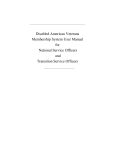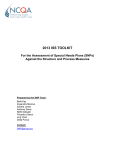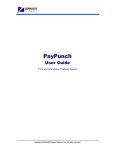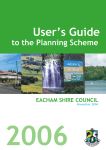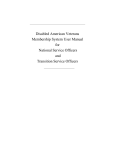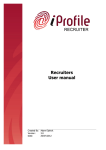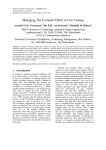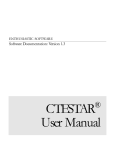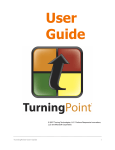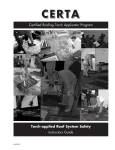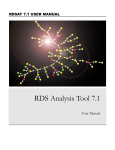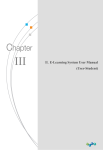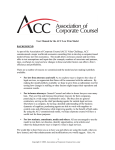Download Operations Manual - Global Health Sciences
Transcript
Conducting HIV Biological-Behavioral Surveillance Among Hard-to-Reach Populations Using Respondent-Driven Sampling Operations Manual Contents Important RDS Terms....................................................................................................1 Section 1. Preparations, Setting Up Operations ........................................................2 A. Interview Site Flow................................................................................................2 B. Management of the Interview Site.........................................................................3 C. Monitoring Recruitment and Data Collection.........................................................6 D. Appointment Vouchers..........................................................................................7 E. Recruitment Coupons ...........................................................................................8 F. Developing a Coupon Tracking System..............................................................12 G. Scheduling Appointments ...................................................................................13 H. Safety Guidelines................................................................................................17 Section 2. RDS Procedures ........................................................................................22 A. RDS Procedures: Overview ................................................................................22 B. RDS Procedures: Interview Process...................................................................24 C. RDS Procedures: Recruiter Incentive Process ...................................................32 D. Monitoring Distribution of Coupons .....................................................................36 Section 3. Seed Recruitment ......................................................................................36 A. Recruiting Seeds Overview.................................................................................36 B. Seed Characteristics...........................................................................................36 Section 4. Participants as Recruiters.........................................................................37 A. Telling Participants About The Opportunity to be a Recruiter .............................37 B. Recruiter Training ...............................................................................................37 C. Recruiter Training Script .....................................................................................41 Operations Manual August 2006 Table of Contents–i Section 5. Managing the Project and the Data ..........................................................43 A. Pacing Recruitment.............................................................................................43 B. Ending Recruitment ............................................................................................44 Section 6. Staff Roles and Responsibilities ..............................................................45 A. Screener .............................................................................................................45 B. Interviewer ..........................................................................................................48 C. Coupon Manager—Primary Incentive .................................................................49 D. Coupon Manager—Secondary Incentive ............................................................51 E. Supervisor...........................................................................................................52 Figures 1.1 Participant Flow During Enrollment and Primary Incentive ........................................2 1.2 Respondent Flow During Secondary Incentive ..........................................................3 1.3 Front of Appointment Voucher ...................................................................................7 1.4 Front of Referral Coupon ...........................................................................................9 1.5 Back of Referral Coupon .........................................................................................10 1.6 Front of Payment Coupon........................................................................................11 1.7 Back of Payment Coupon ........................................................................................12 1.8 Field Safety Summary Sheet ...................................................................................20 1.9 Field Incident Report................................................................................................21 2.1 RDS Procedures......................................................................................................23 2.2 Example of Coupon Identification Numbers.............................................................31 6.1 Flowchart of RDS Staff Roles and Corresponding Forms........................................54 Operations Manual August 2006 Table of Contents–ii Tables 2.1 Coupon Validation ...................................................................................................26 2.2 Ending the Interview Session...................................................................................28 2.3 Secondary Incentive Verification..............................................................................34 Operations Manual August 2006 Table of Contents–iii IMPORTANT RDS TERMS Coupon – Used in RDS studies to provide incentives to participants. Typically, the coupon has two parts that can be easily separated: ▪ One part of the coupon serves as the referral coupon that the recruiter uses to recruit a peer into the study. ▪ The other part of the coupon serves as the payment coupon. It is kept by the recruiter and he or she will use it to claim an incentive for having recruited a peer into the study. Both parts of the coupon have a unique identification number of the recruit printed on them. The dual system eliminates the need to collect names for incentive collection. Incentive – This is a reward or reimbursement given to participants in an RDS study. There are typically two types of incentives: primary incentive and secondary incentive. A participant receives the primary incentive for enrolling in the study and completing the interview process. The same participant receives secondary incentive(s) for recruiting his or her eligible peers into the study. Recruitment Chain – A recruitment chain is made up of a seed and all of his or her recruits. Respondent Driven Sampling – This is a sampling method that relies on social network properties to sample hard-to-reach populations. Seeds – These are non-randomly selected members of the target population who will initiate the RDS recruitment process. From each seed, a recruitment chain is expected to grow. Waves – In RDS recruitment a seed recruits his or her peers which make up the first wave of a chain. The first wave peers recruit peers who make up the second wave of a chain and so on. The waves make up a chain and the grouping of chains make up the sample. Operations Manual August 2006 Page 1 SECTION 1. PREPARATIONS, SETTING U P OPERATIONS A. Interview Site Flow Figures 1.1 and 1.2 indicate the flow of respondent-driven sampling (RDS) activities within an interview site. More detailed instructions on RDS procedures are provided in Section 2 of this operations manual. Figure 1.1 Participant Flow During Enrollment and Primary Incentive Respondent has valid coupon and meets eligibility criteria Respondent consents to behavioral component (biological optional) Screener assigns coupon number to questionnaire Respondent receives recruitment coupons with expiration dates Respondent visits coupon manager Respondent receives primary incentive Respondent has exit interview Operations Manual August 2006 Respondent has face -toface interview Respondent sees laboratory technician and gives blood (Voluntary counseling and Testing pre- and posttest counseling for those who want results) Page 2 Figure 1.2 Respondent Flow During Secondary Incentive Recruiter returns to interview site Recruiter remits payment coupon (check eligibility date) Recruiter completes non response questions Recruiter receives secondary incentive (amount depends on number of successful recruitments) B. Management of the Interview Site 1. Location of the interview site The interview site should be located in an area that is safe for and convenient to participants. 2. Interview site setup The interview site should have several useful rooms. There should be a room at the entryway, where the screener/coupon manager will sit. A waiting room and a small kitchen area for making tea or coffee also should be near the entryway. There should be at least four private rooms for conducting interviews, taking blood spots, and conducting pre- and posttest counseling. The facility also must have a toilet. This interview site should be discreet and not attract undue community concern. The interview site also should be accessible (easy to find and affordable to get to), quiet and private (to ensure participants’ confidentiality and to limit distractions), and spacious enough so that Operations Manual August 2006 Page 3 biological specimens and completed questionnaires can be kept secure and out of the sight of participants and others who are not staff members. The interview site should have enough private rooms so that each interviewer can conduct interviews confidentially. The interview site should have ample space so that participants can comfortably wait to be interviewed. RDS staff members must ensure that study participants’ experiences at the interview site are as pleasant as possible so that participants will feel comfortable about encouraging their peers to participate in the study. RDS staff members also must be prepared to serve refreshments to participants and to make every effort to ensure that participants feel welcome. The supervisor is responsible for ensuring the safety and security of staff members and participants while they are at the interview site. Staff members should be aware of their surroundings at all times. All interview sites should have a safety protocol that describes how to deal with field incidents or adverse events (safety guidelines are discussed in Section 1.8). Given the nature of the RDS sampling method, it is possible that some recruiters may bring other people with them to give coupons to. If that is the case, the other person(s) should not be allowed to wait inside the interview site. They should be told to wait outside and meet their friends outside the interview site. 3. Hours of operation To keep a consistent schedule to avoid any confusion or missed opportunities for enrolling eligible participants, staff members should always open and close the interview site at specified times. During lunch breaks or any other breaks, staff members should close the interview site and not conduct any interviews. A certain number of interviews should be scheduled, so that the interviewers are not overwhelmed. Hours of operation should be clearly displayed on the interview site door in case potential participants show up after the site is closed. On some occasions, participants may arrive just before closing. RDS staff members must decide whether they will allow for latecomers or send them away; however, if latecomers are sent away, they may not return. If recruitment is slow, site staff members should make allowances for latecomers. Operations Manual August 2006 Page 4 4. Materials for the interview site The following items should be readily available in the interview site: ▪ Survey materials – Paper copies of the survey (including the eligibility screener, network questions, and the core questionnaire), test kits and other paraphernalia (if taking biological specimens), coupons, consent forms or scripts, recruiter training script, interviewer guide, response flashcards (if needed), incentives, appointment book, and calendar ▪ Program management/quality assurance – Coupon tracking forms, security incident forms, and receipt book ▪ Office supplies – File cabinets or cases, paper (regular and stock), pens, pencils, stapler with staples, scissors, masking tape, paper cutter, binders, folders, hanging folders, envelopes, stamps, Post-it® notes (or other adhesive notes), chairs (for staff members, interviewees, and others who are waiting), stamp or embosser for coupons, and refreshments ▪ Equipment needs – Computers, Internet access for networking multiple sites, printer, printer cartridges, diskettes, Zip® drives (or other data storage devices), telephone/fax machine, and answering machine ▪ Risk reduction materials – Condoms, lubricants, bleach kits, hygiene kits, safer sex and injection pamphlets, HIV/AIDS and hepatitis pamphlets, and referral information for drug treatment and HIV testing ▪ Posters and signs ▪ Cleaning supplies 5. Developing marketing materials and logos Sites can create marketing materials and logos for project identification. Operations Manual August 2006 Page 5 C. Monitoring Recruitment and Data Collection Successful RDS recruitment and quality data collection are essential if staff members are using the data to make estimates about the population. Therefore, the supervisor should closely monitor these activities on a weekly basis, as part of his/her primary responsibilities. The following are recommended monitoring procedures for the supervisor (Section 6.5 contains a full job description for the supervisor): ▪ Daily basis – During the day-to-day operations of the survey, it is important for the supervisor to be aware of the following: ▪ The number of individuals who refuse to participate in the interview ▪ The number of participants who are found to be ineligible for the interview ▪ The number of participants completing the interview who refuse to become recruiters If large numbers of individuals are refusing the interview, the supervisor should assess how screeners are administering study information and the consent form. If an unusually large number of individuals are determined to be ineligible, the supervisor should assess how the screener is checking eligibility, to ensure that it is being determined correctly. Additionally, if a large number of participants completing the interview refuse to become recruiters, the supervisor should assess how the coupon manager is providing recruiter training. ▪ Weekly basis – The supervisor should hold a weekly meeting with all interview site staff members. This meeting is an important opportunity to debrief any common problems encountered during the week and discuss solutions to those problems. It is also used to discuss what has been going well during the week. Operations Manual August 2006 Page 6 D. Appointment Vouchers An appointment voucher provides an appointment date and time to walk-ins who cannot be accommodated. All appointment vouchers should contain the information described below: Front of voucher (Figure 1.3 below) 1. Unique identification number 2. Name of the project (an outwardly stigmatizing name, such as “AIDS Prevention for Injecting Drug Users,” should not be used) 3. Screening/interview appointment date and time at the interview site (project staff will write this information in the space provided) 4. Address of the field site 5. Phone number (preferably a toll-free number) 6. Statement that the referral card will expire 1 week from the date of the appointment Figure 1.3 Front of Appointment Voucher 2 01.1.2.0.0.0.0 Survey 1 Appointment Voucher 5 You have an appointment at _______________. 4 Time __________ Date _________________ Tel: xxx-xxx-xxxx 3 This card will no longer be valid on _________. Operations Manual August 2006 6 Page 7 Back of voucher 1. Map to the interview location 2. Information about the study The physical appearance of the appointment voucher should differ from that of the coupons used to recruit participants. The following are recommendations for the physical appearance of the appointment voucher: ▪ The appointment vouchers should be printed on paper that is a different color from that used for the coupons. ▪ E. The referral cards should be cut to a size that is a little larger or smaller than the coupons. Recruitment Coupons Coupons are used for recruitment. Each participant will receive three, two, or one coupon, depending on which coupon reduction mechanism is used. Coupons must be easy to track and difficult to reproduce by members of the target population. Each coupon must contain a unique identification number so that it can be used to easily link recruiters with recruits. Coupons should appear to have some value; therefore they should be carefully developed and have a pleasant appearance. The coupon for this project has two parts that can be easily separated. One part of the coupon serves as the “referral coupon,” which the recruiter will use when recruiting a peer into the study. The other part of the coupon serves as the “payment coupon,” which the recruiter will keep in order to claim an incentive for having recruited a peer into the study. Both parts of the same coupon have the unique identification number of the recruit printed on them (the coupon numbering system is described in Section 2). Operations Manual August 2006 Page 8 All referral coupons should contain the information described below: Front of referral coupon (Figure 1.4 below) 1. Unique identification number 2. Name of the project 3. Phone number (preferably a toll-free number) 4. Hours and days of the interview site operation 5. Address of the interview site 6. Expiration date of the coupon (project staff will write this information in the space provided) (e.g., some projects may need to adjust this timeframe according to their recruitment experience) 7. Project logo Figure 1.4 Front of Referral Coupon 2 7 Survey Referral coupon 5 Address: ________________________ Telephone: ___________________________________ (You can call to make an appointment in advance.) 3 ID number: 1 Opening hours: Tuesday–Sunday From 9:00 AM to 5:00 PM 4 6 Expiration date: __________________ Operations Manual August 2006 Page 9 Back of referral coupon (Figure 1.5. below) 1. Name of the project 2. Incentive amount 3. Conditions under which the coupon will not be accepted The back of the coupon can also include space for project staff to write coding (such as the interviewer ID) and a map showing the location of the field site; however, this information is optional. Figure 1.5 Back of Referral Coupon 1 Survey 2 For Your Health and Safety Come with this coupon and, if eligible for participating, you will receive the following benefits: ▪ An incentive of ________ for completing the interview ▪ Free, voluntary/confidential HIV counseling and testing (if requested) 3 This coupon will not be accepted in the following conditions: ▪ The project has reached the target sample size. ▪ This coupon is torn up, tampered with, or unreadable. ▪ The coupon holder has already been interviewed with the same color coupon. Operations Manual August 2006 Page 10 Front of Payment Coupon (Figure 1.6 below) 1. Name of the project 2. Incentive for recruiting peers into the study (secondary incentive) 3. Unique identification number 4. The address and telephone number for the secondary incentive payment 5. Expiration date of the coupon (project staff will write this information in the space provided) (1 week beyond the expiration date on the referral coupon) Figure 1.6 Front of Payment Coupon 1 4 Survey Payment coupon Address: ___________________________________ Telephone: ___________________________________ (You can call to make an appointment in advance.) You will receive a phone card for each recruitee you refer and enroll in the study (up to 3 recruits). 2 3 ID number: Please call us in advance and present this coupon for payment. Expiration for redeeming secondary incentive: _________________ Operations Manual August 2006 5 Page 11 Back of Payment Coupon (Figure 1.7 below) 1. Name of the project 2. Conditions under which the coupon will not be accepted 3. Circumstances under which the recruiter will receive the incentive Figure 1.7 Back of Payment Coupon 1 Survey This coupon will not be accepted in the following conditions: ▪ The project has reached the target sample size. ▪ This coupon is torn up, tampered with, or unreadable. You will receive your incentive if each person you recruited: ▪ is eligible for the study ▪ has not already been interviewed with same color coupon ▪ has completed the behavioral questionnaire ▪ has taken the saliva test 2 3 Please come to our project. We care for you. F. Developing a Coupon Tracking System Each project site should develop a filing and accounting system to track its coupons. 1. Tracking coupons distributed Survey interview sites should keep track of the number of new coupons given out to new recruiters every week. The total number of coupons distributed per week should be recorded in the coupon tracking form. The following are recommendations for tracking the number of coupons distributed: ▪ Coupon distribution should follow the sequence of the coded numbers. ▪ A weekly log should be developed to record the coded numbers of each coupon given to a recruiter. Operations Manual August 2006 Page 12 ▪ At the beginning of each week, the coded number of the first coupon distributed should be recorded. ▪ At the end of each week, the coded number of the last coupon distributed should be recorded. ▪ The total number of coupons distributed for the week should be tallied and recorded on the recruitment monitoring form. 2. Tracking coupons returned Interview sites also should keep track of the number of coupons that have been redeemed by participants at interview site locations, including coupons that have expired and coupons from participants who are found to be ineligible. The total number of coupons returned by participants should be recorded in the coupon tracking form. The following are recommendations for tracking the number of coupons returned: ▪ An envelope or file folder should be used to store all ineligible coupons during the week. ▪ Eligible coupons should be stapled to the consent form. ▪ The dates for each week of data collection should be marked on the envelope/folder. ▪ When a participant returns/redeems a coupon, the coupon should be marked as VOID or USED. Then the coupon should be placed into the envelope/folder corresponding to the current week (or stapled onto the questionnaire, if necessary). ▪ At the end of each week, the number of coupons that are in the week’s envelope or folder should be counted. This is the number of coupons that have been returned. G. Scheduling Appointments This guidance refers to scheduling appointments for screening and interviewing participants. 1. Developing an appointment scheduling system The supervisor should develop an appointment scheduling system conducive to the setting and participant flow of the interview site. Appointments should be scheduled with participants at the interview site through one or a combination of the following procedures: Operations Manual August 2006 Page 13 ▪ Participants can schedule appointments by calling the phone number. ▪ Participants can appear in person to schedule an appointment. ▪ Participants can be seen on a walk-in basis. The supervisor should use discretion in determining the best appointment scheduling procedure for the interview site. Scheduling appointments will allow the staff members to better control participant flow in and out of the interview site and may reduce crowding and loitering. However, interview sites also should allow flexibility for accommodating participants who are walk-ins. To add a structure for handling walk-in appointments, interview sites should: ▪ Set specific walk-in hours (e.g., walk-in hours from 2:00 to 4:00 p.m., Tuesday through Friday) ▪ Schedule and see walk-in appointments on a first-come, first-served basis on the same day, if possible, or on another day, if the participant cannot be accommodated on the day he/she walks into the interview site ▪ Set a specific lunch hour or break times when the interview site is closed and participants are not seen (e.g., interview site hours from 9:00 a.m. to noon and 1:00 to 5:00 p.m.) ▪ 2. Post a no-loitering policy General scheduling procedures Site staff members should consider the following guidelines when scheduling appointments: ▪ Project staff must be professional, patient, and friendly with participants. For the participant, this is the first step of the interview process; therefore it is important for the staff member to set a positive tone during this interaction. ▪ When scheduling appointments, the staff member should allot approximately 10 minutes of the screener’s time for each screening session and approximately 45 minutes for each interview session. These time periods may be adjusted according to each interview site’s experience. ▪ When scheduling an appointment, the staff member should ask the participant for the coded number and the expiration date on his/her coupon (and activation date, if used). BEFORE scheduling the appointment, the staff member also should verify (1) that the participant has Operations Manual August 2006 Page 14 a coupon and (2) that the participant’s coupon is valid. If the participant does not have a coupon or the coupon is not valid, the staff member should not schedule an appointment. If the participant says that he/she does not have his/her coupon readily available, the staff member should ask the participant to call back or return with his/her coupon information. ▪ All appointments should be logged in a schedule book kept at the interview site. When logging the appointments, the staff member should put the coded number of each participant’s coupon next to the allotted appointment time. The participant’s name or identifying information should not be written in the appointment scheduler or schedule book. ▪ The participant should be informed that in addition to any specific waiting time that the interview site typically experiences, it will take approximately 10 minutes for the screening session and 45 minutes for the interview session. These time periods may be adjusted according to each interview site’s experience. ▪ The staff member should inform the participant that he/she should be on time for his/her appointment. If the participant needs to reschedule the appointment, he/she should call before the scheduled appointment time. ▪ The staff member should inform the participant that he/she will first be screened for eligibility and, if found to be eligible for participation in the study, will be given an incentive only AFTER he/she participates in the interview. The participant also should be informed that if he/she is not found to be eligible, he/she will not be given an incentive payment. ▪ 3. The participant should be reminded to bring his/her coupon to the appointment. Phone inquiries In addition to the above guidelines, staff members should use the following guidelines for participants who call to schedule an appointment or inquire about the project: ▪ Staff members should do everything possible to ensure that information provided by the participant over the telephone is kept confidential and private. Any project staff member who answers the project telephone line should make sure that the conversation cannot be overheard by other participants or visitors in the interview site. Study staff members must Operations Manual August 2006 Page 15 use caution so that other participants in close proximity cannot hear any part of a phone conversation. ▪ Each site should develop guidance and scripts (in italics below) for providing information about the project over the telephone, such as the following: a. Greet the participant – Thank you for calling the (name of project). My name is ________________. First, can you please tell me how you heard about the project? b. Offer to set up an appointment – Would you like to set up an appointment to come to our building to see if you are eligible? – [If no]: Thank you for taking the time to call today to learn about our project. c. Check that the participant has a valid coupon – Can you tell me the number that is located in one of the top corners of your coupon? Can you tell me the expiration date on your coupon? – [If coupon invalid]: I’m sorry, but your coupon has expired. We cannot set up an appointment for anyone who has an expired coupon. d. Offer an appointment day and time – We have something available on _____________. Would that work for you? You may also just drop in, but in that case, I cannot guarantee that someone will be able to see you. e. Thank the participant and offer reminders – Please be sure to bring your coupon to your appointment. We cannot interview you if you do not bring a valid coupon with you. – Do you know how to get here? If not, I can give you directions. Thank you for taking the time to call today. Operations Manual August 2006 Page 16 H. Safety Guidelines 1. Introduction The objective of these guidelines is to provide a general overview of safety issues. Each interview site should develop local safety procedures and train field staff on those procedures. It is important for staff members to avoid trouble through common sense and advance planning. Staff members must be alert to their own safety and to that of their coworkers at all times. By adopting the recommendations in these guidelines, staff members will be able to effectively recruit and interview participants while still maintaining their personal safety. 2. ▪ Plan ahead Each site should have an emergency action plan. Staff members should know what they are going to do ahead of time in case things suddenly go very wrong. They should know whom to contact in case of emergency. They also should always know the location of all exits from any point in the interview site. ▪ During interviews, the staff member should always be positioned closest to the door, so an unruly participant will not be stationed between the interviewer and the exit. ▪ Each site should consider developing a code word to indicate that a coworker needs assistance. Staff members might use something like the phrase “bring the red folder.” For example, a staff member who is uncomfortable interviewing a participant alone or needs help with an uncooperative participant can ask a coworker to “bring the red folder,” indicating that he/she needs assistance. 3. ▪ Be alert Staff members should be aware of their surroundings. If a threatening situation arises, staff members should remove themselves from the location immediately. They should leave quickly, but do so carefully and with a “cool head.” ▪ Staff members should use all senses to assess a situation. If something just does not “feel right,” a staff member should not discount that feeling. If a staff member’s intuition indicates that the location is unsafe, then he/she should leave immediately. ▪ Staff members should approach every potential respondent as though he/she is welcoming, but they should be cautious if there are concerns about an individual. Operations Manual August 2006 Page 17 4. ▪ Safeguard computers and other equipment Computers should be stored out of view in a locked, secure place when they are not being used. ▪ Data should be downloaded from the computers to the central database at the end of each day (or at the end of each morning and afternoon). This will minimize data loss if a computer is lost or stolen. 5. ▪ Use common sense The amount of cash available in the interview site (including participant incentives) should be limited. ▪ Staff members should avoid wearing or carrying articles that look valuable. Jewelry, expensive watches, and purses may invite theft. ▪ Staff members should not leave any valuables or project materials in a car unsecured or in view. 6. ▪ End the interview at any point if the participant or the environment becomes a threat Aggressive or threatening individuals – If a staff member is directly confronted by an individual, he/she should employ the following verbal de-escalation techniques: ▪ ▪ Use positioning to create extra space and ensure that the individual is at an angle ▪ Do not smile ▪ Let the individual vent ▪ Listen to and acknowledge the individual’s concerns ▪ Avoid becoming defensive ▪ Use a lower voice, tone, and tempo ▪ Respond to valid complaints Sexual harassment – If a respondent is sexually coming on to or harassing a staff member, the staff member has the right to terminate the interview. If the staff member feels that the respondent is behaving inappropriately, the staff member should first remind the respondent that he/she is only there to interview the respondent and is not interested in any sexual offers. If the respondent continues, the staff member should state that the interview is going Operations Manual August 2006 Page 18 to be terminated if the respondent cannot stay focused on the questions. If this does not work, the staff member should terminate the interview. ▪ Drunk, high, or drowsy respondents – Respondents may be unable to complete the interview or give accurate responses for a variety of reasons. If they have had little sleep or have recently used alcohol or drugs, they may be unable to give coherent answers to questions, nod off, or appear to be very drowsy during the interview. If the staff member has begun the interview and the participant is no longer giving coherent answers, the staff member should stop the interview, thank the respondent for his/her time, and enter a description of what happened in the interviewer comments. 7. ▪ Develop field incident reporting procedures Staff members should set up local safety guidelines and procedures for incident reporting prior to starting work at the field site (See Figure 1.8, Field Safety Summary Sheet). ▪ In the event that an incident occurs, staff members should take the following steps: ▪ Notify the supervisor immediately ▪ Complete a field incident report (Figure 1.9) and submit it to the supervisor Operations Manual August 2006 Page 19 Figure 1.8 Field Safety Summary Sheet Field Safety Summary Sheet ▪ Plan ahead ▪ Make sure every staff member is informed about the times the interview site is open ▪ Know the emergency action plan ▪ Always have at least two staff members at the interview site ▪ Always carry your official project ID and personal ID cards ▪ Keep activities on neutral ground ▪ ▪ Never enter a person’s car or residence ▪ Do not go into known shooting galleries, crack houses, or brothels Be alert ▪ ▪ Be aware of your surroundings and listen to your intuition Limit personal interactions with participants ▪ Do not make change, give donations, buy/receive merchandise, or offer/accept rides ▪ ▪ ▪ ▪ ▪ ▪ Do not lend your cell phone to participants Safeguard your computer ▪ Store your computer out of view in a locked, secure place when it is not in use ▪ Be inconspicuous when carrying and using your computer Keep the interview site locked when no one is inside ▪ Store completed questionnaires, extra computers, and incentives in a secure place ▪ During interviews, always position yourself closest to the door Use common sense ▪ Do not carry a lot of cash or credit cards ▪ Avoid wearing or carrying articles that look valuable End the interview if you feel threatened by the participant or the environment ▪ If necessary, employ verbal de-escalation techniques ▪ Use a password to alert your supervisor (e.g., “bring me the red folder”) Cooperate with the police ▪ If stopped by the police, answer questions, show them your ID, and defer to them ▪ Alert your supervisor or give his/her contact information to police so they can obtain clarification about your activities ▪ Upon entry to a venue, inform security of your presence and explain your activities ▪ Do not break the respondent’s confidentiality ▪ Report field incidents to your supervisor immediately Operations Manual August 2006 Page 20 Figure 1.9 Field Incident Report Field Incident Report Project Area: _______________________________________________________________________ Name of Person Filing Report: _________________________________________________________ Position (check all that apply): Supervisor Screener Coupon Manager Interviewer VCT Counselor Laboratory Technician Other (specify): ______________________________________________________ Location of Incident (name and address): ________________________________________________ _________________________________________________________________________________ Date of Incident (dd/mm/yy): ____ / ____ / ____ Time of Incident: ____ / ____ Description of Incident and Actions Taken:________________________________________________ ---------------------------------------------------------------------------------------------------------------------------------------Incident Reported Locally to (check all that apply) Supervisor Date: ____ / ____ / ____ Time: ____ / ____ Police Date: ____ / ____ / ____ Time: ____ / ____ Other (specify): __________________________________________________________________ Date: ____ / ____ / ____ Time: ____ / ____ (circle one) Incident Reported to Project Officer: Date: ____ / ____ / ____ Time: ____ / ____ Comments (other information relevant to the incident): ______________________________________ _________________________________________________________________________________ Signature of Person Filing Report: __________________________________ Date: ____ / ____ / ____ Give this completed form to: __________________________________________________ Operations Manual August 2006 Page 21 SECTION 2. RDS PROCEDURES A. RDS Procedures: Overview This section assumes that projects will use pen and paper or their own computerized management of coupons. All methods for managing the coupons will be referred to as the coupon manager system. The screener is responsible for screening all potential participants. Screening includes assessing eligibility, obtaining consent, explaining the study procedures, and collecting the referral coupon. The site should designate a coupon manager to be responsible for the distribution and management of coupons. Coupon documentation should be kept in one place or station, near the site’s entryway. (As a useful reminder, Figure 2.1, which indicates the specific flow of the RDS procedures, can be posted at the coupon manager station.) Operations Manual August 2006 Page 22 Figure 2.1 RDS Procedures Validate Coupon Not Valid Stop End Stop End Stop End Stop End Give Incentive End Valid Create Record in Coupon Manager Determine Eligibility Not Eligible Eligible Obtain Consent No Yes Complete Survey No Yes Recruit Others No Yes Train to Recruit Operations Manual Enter Recruiter Info Code for 3, 2, or 1 Coupons August 2006 Give Incentive End Give Coupons Page 23 B. RDS Procedures: Interview Process The following guidance provides an overview of how the coupon tracking form should be used during the coupon redemption and interview process. This same guidance applies to the redemption of appointment vouchers and seed interviews. More detailed instructions on how to operate the coupon manager system will be provided in a separate user manual. While managing coupons and operating the coupon tracking form, staff members should follow these security measures: ▪ New, unused coupons should be stored in a locked file cabinet or drawer. ▪ Each used, voided, and expired/invalid coupon should be filed by the week it was returned and stored in a locked cabinet or drawer. ▪ The coupon list should never be visible to participants. 1. “Check in” participant at coupon manager/eligibility screening station The following activities are the responsibility of the screener. The screener should greet the participant and do the following: ▪ Ask the participant whether he/she has an appointment. If the participant is a walk-in, then the screener should assess whether an interviewer is available. ▪ Ask the participant to present his/her coupon. The participant CANNOT be interviewed if he/she does not present a coupon. If a participant shows for an appointment or walks in without a coupon, the screener can use the following script: I’m sorry, but we can’t begin the screening or any part of the interview process until you bring your coupon with you. We will have to reschedule the screening and interview for another day. Please remember to bring your coupon next time. If the participant does not appear alert or capable of completing the screening and interview session (e.g., the participant appears to be drunk, high, or drowsy), the participant should not be “checked in.” Rather, the screener or supervisor should try to reschedule the participant’s Operations Manual August 2006 Page 24 appointment for another day. The screener should use judgment in how to handle this situation carefully with the participant. For example, the screener can say the following: I’m sorry but our schedule is very full today. Can we reschedule your appointment for another day? Note: If the participant is recognized as a previous respondent (even if the participant has a valid coupon), the screener should not “check in” the participant. The screener should void the coupon and tell the participant that he/she is not eligible to participate. a. Validate the participant’s coupon ▪ If applicable, the screener should check the activation date on the coupon. If the coupon has not yet become active, the screener should ▪ return the coupon to the participant, ▪ ask the participant to return on or make an appointment for the date when the coupon becomes active. ▪ The screener should check the expiration date on the coupon. If the coupon has expired, the screener should ▪ NOT return the coupon to the participant after this point, ▪ mark the coupon VOID and file the expired coupon in the weekly file, ▪ explain to the participant that his/her coupon has expired: I’m sorry, but your coupon has expired. We cannot interview anyone with an expired coupon. Note: An appointment voucher can ONLY be validated by checking the appointment date written on the card against the expiration timeframe (e.g., 1 week). The appointment card cannot be validated by searching for the number in the coupon tracking form. This is because the appointment card was given to the seed through outreach or a key informant; therefore the appointment card is not linked to the coupon number of a peer recruiter and is not located within the coupon tracking form. The screener should follow Table 2.1 in determining whether or not the coupon is valid. Operations Manual August 2006 Page 25 Table 2.1 Coupon Validation The coupon is VALID if the The coupon is INVALID if the payment status is… payment status is… The coupon HAS been redeemed, The coupon HAS UNPAID PAID NOT been the primary incentive. redeemed, and the The coupon HAS been redeemed, recruiter HAS NOT PENDING been paid the but the recruiter HAS NOT yet been paid the primary incentive. primary incentive for VOID recruiting. ▪ and the recruiter HAS been paid The coupon has EXPIRED or been VOIDED. If the participant’s coupon is INVALID, the screener should ▪ NOT return the coupon to the participant, ▪ mark the coupon VOID and file the invalid coupon in the weekly file, ▪ explain to the participant that his/her coupon is no longer valid: I’m sorry, but your coupon is no longer valid. We cannot interview anyone with an invalid coupon. ▪ If the participant’s coupon is VALID, the screener should ▪ b. record the coupon number for the participant in the coupon tracking form. Screen for eligibility After validating the coupon, the screener will screen the participant for eligibility. If the participant is NOT eligible, the screener will ▪ tell the participant that he/she is not eligible for the survey and end the interview session, ▪ note that the participant is ineligible in the coupon tracking form and void the coupon number, ▪ escort the participant to the exit. Operations Manual August 2006 Page 26 c. Obtain consent If the participant is eligible, the screener will read the consent script. If the participant chooses NOT to participate in the survey and/or is unable to complete the consent process, the screener should ▪ mark the appropriate box on the consent form, ▪ end the interview session, ▪ note that the participant refuses consent in the coupon tracking form and void the coupon number, ▪ escort the participant to the exit. d. Escort participant to interviewer If the participant chooses to continue with the survey, the screener should ▪ introduce the participant to the interviewer, ▪ provide the questionnaire with the coupon number to the interviewer. If the interviewer knows the participant, the interviewer should assign a different interviewer to the participant. 2. Conduct interview session The interviewer is responsible for the survey activities. ▪ The survey is considered to be complete after the interviewer has finished administering the network questions and the participant has completed the entire behavioral questionnaire. If the participant does NOT and/or is UNABLE to complete any part of the questionnaire, the interviewer should ▪ end the interview session, ▪ bring BOTH the participant AND the participant’s questionnaire back to the screener or to the supervisor. If the participant completes the survey, the interviewer should escort the participant to the laboratory technician for a dried blood spot sample. Operations Manual August 2006 Page 27 3. Take a blood spot If the participant chooses NOT to provide a blood spot, the laboratory technician should ▪ end the interview session, ▪ bring the participant to the screener or supervisor. If the participant provides a blood spot, the laboratory technician should ask the participant if he/she would like to receive the test results: ▪ If the participant says “yes,” then the technician must escort him/her to the VCT counselor before taking blood a blood spot. ▪ 4. If the participant says “no,” then the technician may take a blood spot. Explain the recruitment process and distribute recruitment coupons If the participant chooses NOT to be a recruiter, the coupon manager should provide the primary incentive to the participant and have the participant leaves the premises. If the participant chooses to be a recruiter, the coupon manager should explain the recruitment process and provide the participant with three, two, or one coupon. The interviewer should follow the actions in Table 2.2 after it is determined whether the participant should receive the primary incentive. Primary incentive payments should only be disbursed by the coupon manager. Table 2.2 Ending the Interview Session If the participant SHOULD receive the primary incentive for the interview: 1 Escort the participant back to the COUPON MANAGER 1 If the participant SHOULD NOT receive the primary incentive for the interview:2 Escort the participant to the EXIT Participants should receive a primary incentive if they were eligible and completed all of the survey 2 requirements. Participants should not receive a primary incentive if they (1) were not eligible for the survey or (2) did not give consent to participate in the survey. Operations Manual August 2006 Page 28 5. Complete participant’s record and enter recruiter information using the coupon tracking form The screener is responsible for the activities in the following sections. a. Complete participant’s record The screener should complete the participant’s record if the interview session ended because the participant (1) was ineligible for the survey or (2) DID NOT consent to the survey. Note: If the interview session ended because the participant was incapable of completing the eligibility screening or giving consent (e.g., the participant appeared to be drunk, high, or drowsy), the screener SHOULD NOT schedule a new appointment for the participant. Neither the participant nor the recruiter will receive an incentive or reward. The coupon should be voided and placed in the “voided coupons” folder. ▪ If the participant completed the survey, but DID NOT agree to be a recruiter, the screener should ▪ ▪ pay the participant the incentive for the interview, ▪ mark the coupon USED and file the used coupon in the weekly file. If the participant completed the survey AND AGREED to be a recruiter, the screener should ▪ enter the participant’s (now new recruiter’s) information into the coupon tracking form; ▪ pay the participant (new recruiter) the incentive for the interview; ▪ give the participant (new recruiter) three, two, or one new coupon, depending on the wave (see Section 5.1c); ▪ b. mark the coupon USED and file the used coupon in the weekly file. Enter recruiter information After the participant becomes a recruiter, the screener should ▪ select three (or two or one) blank coupons and record the identification numbers onto the coupons, Operations Manual August 2006 Page 29 ▪ record the coupon number into the coupon tracking form, ▪ provide the coupons to the recruiter and explain the recruitment process. Note: It is very important for the screener to pay careful attention when entering/creating the unique identification number and then to double-check the number. The smallest data entry error or typo can make disbursement of recruiter incentives problematic. 6. Coupon numbering The coupon numbering system described below uses the systematic coupon numbering method. Depending on the number of seeds, the coupon numbering system will start with a unique number provided to the seed. For example, in a study with 9 seeds, the first two digits on each coupon will begin numbering with 1, the second coupon’s first two digits will be 2, and so on, up to 9. For example, Seed 1 has the number 1.0.0.0.0.0.0 Seed 2 2.0.0.0.0.0.0 Seed 3 3.0.0.0.0.0.0 ………….until Seed 10 9.0.0.0.0.0.0 Because most RDS studies only allow for recruiters to recruit up to three peers, the numbers following the seeds’ numbers are 1, 2, or 3. For example, if seed number 5 was interviewed and provided with three coupons, then the recruits for seed number 05 would receive the following coupon identification numbers: 5.1.0.0.0.0.0, 5.2.0.0.0.0.0, or 5.3.0.0.0.0.0 (Figure 2.2). If a recruit with coupon 5.3.0.0.0.0.0 was interviewed, then he/she would receive coupons with the identification numbers of 5.3.1.0.0.0.0, 5.3.2.0.0.0.0, or 5.3.3.0.0.0.0 (Note: the dots used between the digits are for clarity in explaining the numbering system. Do not use the dots when entering the coupon number into your database as RDSAT will not read them correctly). This process occurs according to the number of waves produced by each seed. Operations Manual August 2006 Page 30 Figure 2.2 Example of Coupon Identification Numbers 5.0.0.0.0.0.0 5.1.0.0.0.0.0 5.1.1.0.0.0.0 5.1.2.0.0.0.0 5.1.3.0.0.0.0 5.2.0.0.0.0.0 5.2.1.0.0.0.0 5.2.2.0.0.0.0 5.2.3.0.0.0.0 5.3.0.0.0.0.0 5.3.1.0.0.0.0 5.3.2.0.0.0.0 5.3.3.0.0.0.0 Coding the coupons in this manner makes it easier to manage the progress of the seeds and to track which seeds are efficient recruiters and which seeds did not recruit anyone. The coding is also helpful in keeping track of the number of waves completed by each seed. The first two digits identify the seed, the second digit is wave 1, the third digit is wave 2, and so on. For example, if someone with coupon identification number 5.3.3.1.2.2.0 enters the study, it is easy to see that seed number 05 has recruited five waves. This designation is especially useful if the program wants to end recruitment for each seed at a certain wave. Because the suggested coupon identification numbers are not preprinted, they must be carefully recorded onto the coupon by the coupon manager. Having the interviewers record the identification numbers onto the coupon could introduce error (e.g., writing down the wrong coupon number). However, because the digits following the two initial digits for the seed can only be 1, 2, or 3, the potential for error is reduced. If a number beyond the first two digits is larger than three, it is easy to detect and correct the mistake. 7. a. Disburse incentives and coupons Paying participants for the interview All participants will receive a primary incentive of (add your incentive amount here) for completing the survey and providing a blood spot. Participants who partially complete the survey will not receive the incentive. Operations Manual August 2006 Page 31 Participants should not be paid an incentive in the following situations: ▪ A participant decides to leave before the screening session. ▪ A participant is screened and found to be ineligible for the survey. ▪ A participant does not complete the survey. b. Disbursing coupons to new recruiters For participants who have agreed to be recruiters and who have received the recruiter training, the coupon manager should follow these steps after completing the RDS procedures: interview process steps described in Section 2. ▪ Take the primary incentive (for completing the interview) out of the locked file or drawer ▪ Take three (or two or one) new coupons out of the current week’s envelope, which should be kept in the locked file cabinet or drawer ▪ Use the participant (no recruiter) unique identification number to derive the correct identification numbers for the recruitment coupons ▪ Enter the coded numbers on these coupons into the new recruiter’s record of the coupon tracking form ▪ Write the expiration date (and validation date, if used) on each coupon ▪ Give the new recruiter the three (or two or one) coupons and the primary incentive C. RDS Procedures: Recruiter Incentive Process The coupon manager is responsible for the following activities. The following guidance provides an overview of how the coupon tracking form should be used when recruiters collect their secondary incentives (for recruiting their peers into the study). More detailed instructions on how to use the RDS coupon tracking form will be provided in separate instructions. Recruiters will receive a secondary incentive of (put your incentive amount here) for each of the three (or two or one) coupons that are redeemed by eligible participants who complete the survey. The coupon tracking form will store and provide information regarding whether a Operations Manual August 2006 Page 32 recruiter is eligible for payment and how much the recruiter is owed; therefore the distribution of recruiter rewards should be coordinated with the coupon manager. The following should be considered when paying recruiter rewards: ▪ Recruiters may call the field site to inquire whether or not their recruits have come in and completed the eligibility screener and survey. It is important to tell recruiters that they must appear at the interview site in person to collect their secondary incentive(s). Note: Appointments should be scheduled with recruiters for disbursing reward payments. ▪ If a person calls or appears at the interview site and says that he/she was sent by a recruiter to collect the secondary incentive(s), this person should be told that payment can only be made directly to the recruiter. ▪ If a participant to whom the recruiter gave a coupon is unable to complete the survey or chooses to end the interview early, local protocol should determine whether or not the recruiter should receive a secondary incentive for the incomplete interview. ▪ If a participant to whom the recruiter gave a coupon is found to be INELIGIBLE for the survey, the site should explain to the recruiter that the person who redeemed the coupon was not eligible to participate and therefore he/she is not eligible for a secondary incentive. Similarly, if the participant to whom the recruiter gave a coupon declines to participate in the survey, the recruiter will not receive a secondary incentive. The following security measures for disbursing the secondary incentives and operating the coupon tracking form should be used: ▪ Secondary incentives should be stored in a locked file cabinet or drawer. ▪ The screens of the coupon tracking form should never be visible to participants. ▪ The coupon tracking form should never be left open and unattended. ▪ Only a few project staff members (two or three) should be trained to use the coupon tracking form. Operations Manual August 2006 Page 33 1. ▪ Verify the secondary incentive amount owed In the recruiter’s open record, the coupon manager should view the payment status next to each coupon given out (Table 2.3). ▪ For each coupon with the payment status of “PENDING,” the recruiter will receive a secondary incentive of (put your incentive amount here) value. ▪ If the recruiter is owed a secondary incentive payment, the coupon manager should administer the non-response questions (see below on administering non-response questions). Table 2.3 Secondary Incentive Verification The secondary incentive is DUE if the The secondary incentive is NOT DUE if the payment status is… payment status is… The coupon HAS been redeemed, The coupon HAS been PENDING PAID and the recruiter HAS been paid redeemed, but the the secondary incentive. recruiter HAS NOT yet The coupon HAS NOT been been paid the secondary incentive. UNPAID redeemed, and the recruiter HAS NOT been paid the secondary incentive. VOID 2. The coupon has EXPIRED or been VOIDED. Administer non-response questions The coupon manager should administer the following non-response questions: a. How many of the three (or two or one) coupons did you give out? ▪ This question refers to the number of coupons that the recruiter handed out to other individuals. ▪ It is possible for a recruiter to hand out less than three coupons (e.g., if he/she knows only two peers or has given out only two coupons to date). Operations Manual August 2006 Page 34 b. Has anyone refused the coupons? ▪ This question determines whether anyone did not take a coupon from the recruiter for ANY reason. ▪ Yes (fill out the non-response questionnaire) or no should be checked. The coupon manager should administer the non-response questions every time the recruiter is paid his/her secondary incentive(s). The coupon manager should: ▪ Explain to the recruiter that questions he/she was previously asked may be repeated ▪ Explain to the recruiter that he/she is being asked to provide cumulative responses each time he/she answers the questions In other words, the recruiter’s total responses should be collected each time the recruiter questions are administered. The coupon manager can help the recruiter remember by telling him/her what has already been recorded. Example: The first time the recruiter answered the non-response questions, he said that he had given out two coupons. The second time the recruiter answered the recruiter questions, he said that he had given out one coupon. In this case, the project staff member administering the questions should clarify by asking the respondent the following: Last time you were here, you said you gave out two coupons. This time you’re saying you gave out one. Do you mean that you gave out one coupon since you last answered this question and that you’ve given out three coupons altogether? 3. Pay recruiter secondary incentive The coupon manager should: ▪ Fill in the coupon tracking form, record payment of the secondary incentive ▪ Retrieve the secondary incentive amount from the locked file or drawer ▪ Give the recruiter his/her secondary incentive Operations Manual August 2006 Page 35 D. Monitoring Distribution of Coupons 1. Tracking coupons The supervisor is responsible for monitoring participant recruitment and coupon distribution, including how many coded coupons were redeemed by participants and how many coded coupons are still outstanding. ▪ Coupons Unpaid – the total number of coupons given that have yet to be redeemed by participants ▪ Coupons Voided – the total number of coupons that have expired or are invalid This information should be used to (1) estimate the number of participants who still need to be recruited for the survey and (2) determine when to stop issuing new coupons. (Specific guidance is provided in Section 5 of this manual.) This information also can be used for developing complete process indicator reports. SECTION 3. SEED RECRUITMENT A. Recruiting Seeds Overview The total number of seeds to start with is eight. If the initial eight seeds do not work out (i.e., the seeds do not recruit two or three other peers), then recruitment of additional seeds may be necessary. Decisions about when to recruit more seeds should be made in consultation with the RDS supervisor and based on a review of the process indicator forms. Seeds must meet all eligibility criteria, just like the other respondents. This requirement should be made clear when recruiting seeds into the study so that they are aware that they may not be enrolled in the project. However, careful seed selection should result in few ineligible seeds. B. Seed Characteristics The protocol indicates that seeds should be “dynamic.” Below is some information on what is meant by “dynamic.” An individual seed should be someone who has the following main features: ▪ Is connected to many other people – A good seed will know a lot of other members of the target population. Operations Manual August 2006 Page 36 ▪ Is trusted and well liked – People who are considered “opinion leaders” within their circle of friends or associates will make effective seeds as they can persuade others to participate in the study and to recruit others. A good seed is someone whom other target population members or the broader target population community go to for information or advice. ▪ Communicates well orally – Seeds should be able to express themselves clearly with site staff members when engaged in an informal conversation; if they can, they probably have the ability to explain the study to others. People who are dynamic in a verbal sense (e.g., extroverted, talkative) but not connected to others will not make good seeds. The best seeds are people who understand the project, support its goals and objectives, and can accurately and enthusiastically persuade others to participate. SECTION 4. PARTICIPANTS AS RECRUITERS A. Telling Participants About The Opportunity to be a Recruiter When a participant completes the survey, the coupon manager should tell him/her about how to recruit others; this will be done once the participant has agreed to be a recruiter. The following key points should be made when a staff member talks about the opportunity to be a recruiter: ▪ It is completely voluntary. Participants do not have to be recruiters if they do not want to, and they will still be paid for completing the survey. ▪ It is important to the project. The success of the project relies on people recruiting others, to get a large sample of participants across the area where you are conducting RDS. ▪ Participants have a chance to earn (put your secondary incentive amount here) per person recruited, with a certain maximum number of people recruited, which changes during the study. It is not guaranteed that he/she will earn ______ per person recruited, but if he/she follows the site’s instructions for recruiting, it is likely that he/she will. B. Recruiter Training Once a participant agrees to be a recruiter, the coupon manager should train him/her on how to recruit others. Below is some information that the coupon manager should tell the new recruiter as part of the training. The recruiter training script is discussed later in this section. Operations Manual August 2006 Page 37 The script will need to be revised during the study period in conjunction with pacing and ending the project to let recruiters know the current number of coupons being given out or the fact that the project will stop giving them out altogether, as well as when the last day of the project will be. In addition, scripts should reflect local protocol regarding incentive payments for recruiters if a participant does not complete the entire survey. 1. Recruiting Others We are going to give you some coupons to give to other people you know who are similar to you so that they can be in the study too. Like you did, they will have to answer questions to determine if they are eligible for the study. They could be people you socialize with, work with, or know through other means. You should give the coupon to someone you know, not a stranger. If you give the coupons to people you know, you are more likely to get the incentive for recruiting other people. ▪ The following key points should be made in this part of the script: a. The recruiter should give the coupon to someone he/she knows, not a stranger (RDS is based on networks, so the program wants people to recruit others they know, not just anyone on the street). b. The recruiter should give the coupon to someone he/she knows and who has similar behaviors. 2. Coupons To be in the study, everyone has to have a coupon. Be sure to tell the people you give a coupon to that they need to have the coupon with them when they call or come in to make an appointment. The first thing we will do is check to see if their coupon is valid. ▪ The following key points should be made in this part of the script: a. Everyone has to have a coupon to be in the study. b. Potential participants need to make an appointment to get into the study. ▪ The recruiter should tell the potential participant to have the coupon when he/she calls or comes in to make an appointment. Operations Manual August 2006 Page 38 Each coupon has a date when it expires, and after that date it cannot be used anymore. So, you should tell people you give the coupon to that they need to call or come in to make an appointment before the date written on the coupon. If you lose a coupon or it gets stolen, it cannot be replaced. ▪ The following key points should be made in this part of the script: a. Coupons are only good for 2 weeks (or the amount of time your study requires), so recruiters should ▪ give out the coupons as soon as possible, ▪ tell the people they give the coupon to that they need to make an appointment as soon as possible. b. Lost or stolen coupons will not be replaced. 3. Time commitment We will not conduct an interview with anyone who is under the influence of drugs or alcohol. Be sure to tell the people you recruit to make an appointment for a day and time when they can expect to be able to complete the whole survey process, which takes about 45 minutes to 1 hour. People you give coupons to who complete the survey will be given (put your incentive amount here), like you will today. ▪ The following key points should be made in this part of the script: a. People who are not capable of completing the interview will not be eligible. Therefore, it is in the best interest of the recruiter and the participant that the participant does not come to the appointment drunk or high (under the influence of drugs). b. The whole process for the study takes about 45 minutes to 1 hour, so participants should make an appointment when they have time. c. Everyone who completes an interview at any time during the study will get _______ as an incentive. Operations Manual August 2006 Page 39 4. Secondary incentives for recruiting You will get a secondary incentive for recruiting people who are eligible and complete an interview. You have a chance to recruit other people like you and get paid for recruiting them; however, it is not guaranteed that you will get the incentive for recruiting someone. ▪ You will not be paid for someone who is not eligible. ▪ You may not recruit someone else using the same coupon or get another coupon if the person you gave it to turns out to be ineligible. ▪ You will not be paid for someone who does not complete an interview. If the person does not complete the interview, the person will not be paid and you will not be paid. ▪ You will not be paid for someone who has already completed the interview. ▪ The key point to be made in this part of the script is that recruiters will get (put your secondary incentive amount here) for each person whom they successfully recruit; the incentive worth (put your secondary incentive amount here) is not guaranteed just because they give someone a coupon. At this point in our study, we are giving people three coupons (or two or one) to use to recruit others. The number of coupons given out will change throughout the study, so when you give the coupon to other people and they become part of the study, they might get a different number of coupons than you did. The study is time limited, so eventually no more coupons will be given out and no more interviews will be conducted. ▪ The following key points should be made in this part of the script: 1. The number of coupons that any recruiter may be given by the project will vary during the study period. The project does not want the “word on the street” to be that everyone can get _____ incentive for recruiting because there may be reasons to vary incentive amounts during the study, and the number of coupons will be reduced toward the end of the study. 2. Eventually, the study will end, and there will be no more opportunities for doing the survey or recruiting others. Operations Manual August 2006 Page 40 5. Recruiter questions When you come in, we are also going to ask you about people who refused to take a coupon from you. What we will want to know is why they refused. The key point to be made in this part of the script is that the recruiter should remember as best as he/she can about the people who refused coupons, and why. You can call our office to see if the people you gave coupons to were eligible and completed an interview, so that you can come in to get your secondary incentive. We cannot tell you who came in or not, but we can tell you whether you can get a reward. Since the person has until a certain time to come in for the interview (1 week from the time you are receiving these coupons), you will know that no secondary incentive will be available to you before that date. ▪ The following key points should be made in this part of the script: a. The recruiter can call the office to find out if he/she is due a secondary incentive. b. The office cannot tell the recruiter who came in with a coupon. 6. Wrap-up Do you have any questions? Okay, remember, give the coupon to someone you know and who is like you. Thanks for helping us! ▪ The following key points should be made in this part of the script: a. Project staff members are available to answer any of the recruiter’s questions. b. The project is thankful for the recruiter’s help. C. Recruiter Training Script 1. Recruiting others We are going to give you three coupons to give to other people you know who are similar to you so that they can be in the study too. Like you did, they will have to answer questions to determine if they are eligible for the study. You should give the coupon to someone you know, not a stranger. If you give the coupons to people you know, and you know they are like you, you are more likely to get the reward for recruiting other people. Operations Manual August 2006 Page 41 2. Coupons To be in the study, everyone has to have a coupon. Be sure to tell the people you give a coupon to that they need to have the coupon with them when they call or come in to make an appointment. The first thing we will do is check to see if their coupon is valid. Each coupon has a date when it expires, and after that date it cannot be used anymore. So, you should tell people you give the coupon to that they need to call or come in to make an appointment before the date written on the coupon. If you lose a coupon or it gets stolen, it cannot be replaced. 3. Time We will not conduct an interview with anyone who is under the influence of drugs or alcohol. Be sure to tell the people you recruit to make an appointment for a day and time when they can expect to be able to complete the whole survey process, which takes about 45 minutes to 1 hour. People you give coupons to who complete the survey will be given ______, like you will today. 4. Secondary incentive You will get a secondary incentive for recruiting people who are eligible and complete an interview. You have a chance to recruit other people who are similar to you and get paid for recruiting them; however, it is not guaranteed that you will get (put your secondary incentive amount here) for recruiting someone. ▪ You will not be paid for someone who is not eligible. ▪ You may not recruit someone else using the same coupon or get another coupon if the person you gave it to turns out to be ineligible. ▪ You will not be paid for someone who does not complete an interview. If the person does not complete the interview, the person will not be paid and you will not be paid. ▪ You will not be paid for someone who has already completed the interview. At this point in our study, we are giving people three coupons to use to recruit others. The number of coupons given out will change throughout the study, so when you give the coupons to other people and they become part of the study, they might get a different number of coupons than you did. The study is time limited, so eventually no more coupons will be given out and no more interviews will be conducted. Operations Manual August 2006 Page 42 5. Recruiter questions When you come in, we are also going to ask you about people who refused to take a coupon from you. What we will want to know is why they refused and some other things about their characteristics (whether they are male or female). You can call our office to see if the people you gave coupons to were eligible and completed an interview, so that you can come in to get your reward. We cannot tell you who came in or not, but we can tell you whether you can get a secondary incentive. 6. Wrap-up Do you have any questions? Okay, remember, give the coupon to someone you know and who is similar to you. Thanks for helping us! SECTION 5. MANAGING THE PROJECT AND THE DATA A. Pacing Recruitment Recruitment should be conducted at a pace so that everyone does not show up at the same time. Recruitment pace should be controlled to ▪ maximize recruitment from all possible geographic locations, ▪ recruit participants from all possible networks, ▪ capture seasonal variations in participant activities, ▪ avoid crowding at the interview site, ▪ prevent the survey staff from being overwhelmed, ▪ maintain the safety of the staff and project materials. 1. Determine the number of interviews per day The interview site location has established operating hours. Only a set number of interviews should be conducted during those hours. Scheduling interviews, rather than having all walk-in appointments, will help ensure that a steady pace of interviews is maintained. Example: Within 2 weeks of implementation of the RDS pilot study, the interview site was overcrowded with participants, and the safety of staff members and study materials became an issue. Tenants from adjacent buildings filed complaints with the local police because of Operations Manual August 2006 Page 43 participants waiting outside the interview site. To address these problems, the study staff members began to schedule all interviews, and they only conducted a set number of interviews in a given week. Only those participants with a valid coupon were scheduled for an interview, and only those with appointments could wait inside the interview site. Participants outside the interview site were told not to wait. These measures helped improve the situation, and no further complaints were made to the police. 2. Use expiration dates, consider activation dates All coupons must have an expiration date, which is at least 1 week from the day the coupon was distributed to the recruiter. This feature will allow staff members to maintain more control over the number of outstanding coupons. Activation dates can also be used to help pace recruitment. Example: When the RDS pilot was implemented, the coupons did not have activation or expiration dates. Recruiters would sometime distribute the coupons they received immediately to those waiting outside. Then the recruiter would wait for the recruit to be screened and interviewed so that the recruiter could get the rewards for recruiting. By introducing coupon activation date (2 days after the date when the coupons were given to the recruiter), the recruiter had to wait at least 2 days to receive the reward for distributing coupons. Introduction of this measure not only minimized overcrowding, but it also paced the recruitment. The expiration date on the coupons will help to make sure that someone does not show up after the project has ended. It also will help to speed up the process of coupon distribution; thus, the recruiter should distribute the coupons as soon as possible and not hold on to them too long. 3. Changes in coupon distribution The survey project will use a process that reduces the number of coupons as the study progresses. At wave 3, the number of coupons for recruitment will be reduced to two; at wave 5 and all subsequent waves, the number of coupons for recruitment will be reduced to one. Any modifications or changes with regard to coupon distribution, other than that mentioned above, must be discussed with the supervisor. B. Ending Recruitment A minimum of 400 eligible participants will be interviewed at the interview site in (put the site location here). Data collection for the survey project will end once the sample size of 400 is reached. Operations Manual August 2006 Page 44 Coupon distribution will need to be phased out prior to the end of the cycle. Other projects’ experience with RDS has shown that for every three coupons distributed, approximately two coupons are redeemed by eligible participants. This coupon return rate should be kept in mind as coupons are distributed. Expiration dates may need to be modified during the course of the study period (e.g., to shorten the timeframe toward the end of the cycle). In addition, as the project reaches the end of the study period, the number of coupons distributed to each recruiter will be slowly reduced (e.g., from three to two, to one, to none). The reduction of coupons, as well as a coupon expiration date from the time the recruiter receives his/her coupons, will ensure that the study ends smoothly. There is no set formula or specific timeframe for successfully ending an RDS project. It will depend on each interview site’s coupon return rate, the number of waves of recruitment completed, and the duration of the study period. SECTION 6. STAFF ROLES AND RESPONSIBILITIES A. Screener The screener reports directly to the RDS supervisor. The screener is usually the first person with whom a potential participant will come in contact. The screener is responsible for greeting and welcoming the participant and ensuring that he/she feels comfortable at the interview site. 1. Checking coupon validity The screener will ask the potential participant for his/her coupon and will review it for validity: ▪ Is it an actual coupon for the assessment (i.e., is the color correct, has it been tampered with, and can the coupon number be clearly seen)? ▪ Has the expiration date passed? Once the screener reviews the coupon and determines that it is valid, the screener will keep the coupon. If the screener determines that the coupon is not valid, he/she will tell the potential participant that it is not valid and will file the coupon in a large manila envelope. (The screener should not give the coupon back to the potential participant.) Operations Manual August 2006 Page 45 2. Determining eligibility The screener will use the eligibility criteria to determine whether the potential participant is eligible to enroll in the assessment. The eligibility criteria are as follows: ▪ (put your specific eligibility criteria here) ▪ ▪ ▪ The screener will complete the eligibility form and ask the network question. The screener should staple the participant’s coupon to the eligibility/network question form. 3. Obtaining consent In obtaining consent, the screener must read the entire consent form to the potential participant. During the reading of the consent form, the screener should stop to explain certain sections that the potential participant may not understand. The screener should encourage the potential participant to ask questions if there is something that he/she does not understand. Once the consent form has been reviewed and is understood by the potential participant, he/she must sign and date the consent form in the spaces available. The screener should remind the potential participant that this assessment is anonymous, so he/she does not need to write his/her real name. If the potential participant is unable to sign the consent form or prefers not to sign it, then a witness can sign it on behalf of the potential participant. During the reading and discussion of the consent form, the screener can explain the important parts of the assessment to the potential participant. After obtaining consent, the screener should write the participant’s coupon number on a blank questionnaire. 4. Screening questions The eligibility criteria are intended to help include, not exclude, potential participants. If staff members are unsure about the membership of a particular person to the target population, they should consider asking some screening questions. When asking the screening questions, staff members should know the correct answer themselves. Operations Manual August 2006 Page 46 Potential participants should only be eliminated if the screener is 100% sure that they are not members of the target population; otherwise they should be let into the study. 5. Non-eligibility and non-response forms If the potential participant is not eligible or refuses to participate, the screener should complete the non-eligibility form or the non-response form. 6. Checklist Every participant is required to carry a checklist form with them throughout the study process to ensure that they complete every step of the study. As the participant completes each step of the study, a staff member will check the appropriate box and sign the checklist form. The screener will fill in the participant’s coupon number and the date. Then the screener will check off the box showing that the participant has completed the eligibility verification and has given consent for participation. Once the appropriate sections of the checklist are completed, the screener will explain to the participant that he/she needs to carry the checklist form with him/her and present it at the end of the assessment in order to receive the primary incentive. 7. Preparing the questionnaire The participant’s coupon number must be written in clear block letters on the questionnaire, where it says “coupon number.” The screener is responsible for ensuring that the correct coupon number is written on the questionnaire. 8. Making appointments The screener is responsible for making appointments with potential respondents if he/she thinks that there are already too many people waiting to be screened. In this situation, the potential respondent will be asked to make an appointment to return to the RDS interview site at a later date. The screener will maintain a daily appointment form, which provides dates and hours during which potential participants can show up for an appointment. The screener should assess whether the individual had to travel a long distance to get to the RDS interview site, and if so, an attempt should be made to accommodate that person. The screener or supervisor can use an appointment voucher for making appointments. 9. Completing the screening The screener should ask the participant if he/she has any questions before proceeding to the interview. Once the screener is confident that all questions and concerns have been addressed, Operations Manual August 2006 Page 47 the participant is free to accompany the interviewer to an interview room. The screener should ensure that the interviewer receives the correct questionnaire with the participant’s accurate coupon number written on it. Materials for the screener • Pencils • Pens • Notepads • Paper clips, stapler with staples • Blank checklist forms, non-eligibility forms, non-response forms, consent forms • Blank questionnaires • Envelopes to store redeemed coupons and completed non-eligibility, non-response, and consent forms B. Interviewer The interviewer reports directly to the team supervisor. The interviewer will escort the participant to a private interviewing area to conduct a face-to-face interview. The interviewer should spend a little time chatting with the participant in an effort to build rapport and to put the participant at ease. Once the interviewer feels that the participant is comfortable, he/she can commence with the interview. The interviewer is responsible for the following: ▪ Bringing the respondent to the interviewing area ▪ Building rapport with the respondent ▪ Conducting the interview in a nonjudgmental manner and ensuring that respondents’ answers to questions are recorded immediately ▪ Ensuring that the accurate ID number and coupon number are on the questionnaire ▪ Ensuring that the interview is private, no onlookers (except the supervisor) are present at the interview room, and information remains confidential ▪ Reporting promptly to the supervisor and screener if the respondent is unable to continue with the interview or when there are problems ▪ Carrying out any other activities as needed Operations Manual August 2006 Page 48 Once the interviewer completes the interview, he/she will complete the checklist form provided by the participant. After signing the appropriate section of the checklist form, the interviewer returns it to the participant and escorts him/her to the laboratory where he/she will give blood specimens to the laboratory technician. Materials for the interviewer • Pencils • Pens • Notepads C. Coupon Manager—Primary Incentive After the laboratory and clinical parts have been completed, the respondent will be brought to the coupon manager. The coupon manager reports directly to the supervisor. The coupon manager will collect and review the participant’s checklist form to ensure that all of the previous steps in the assessment have been completed. If the participant has missed one of the previous assessment steps, then the coupon manager should escort the participant back to the step he/she missed. If the participant has completed each of the required steps, the coupon manager will produce the coupons. At this point, the coupon manager will retain the checklist form. 1. Producing the coupons The coupon manager will produce the coupons for the participant by writing in the correct coupon identification number and the expiration date on each of the coupons to be provided to the participant. The coupon manager will determine from the coupon identification numbers the correct number of coupons to distribute to the participant, on the basis of the participant’s wave: ▪ Three coupons from seed to wave 2 ▪ Two coupons for waves 3 and 4 ▪ One coupon for wave 5 and all subsequent waves 2. Explaining the recruitment process The coupon manager will explain the recruitment process to the participant and give the participant three, two, or one coupon, depending on the wave. Operations Manual August 2006 Page 49 3. Paying out the primary incentive The coupon manager will oversee the monetary incentive for the study. When a participant completes all of the required steps in the study, the coupon manager will pay him/her the primary incentive. The coupon manager is responsible for recording the payment of the primary incentive in the logbook and ensuring that there is an adequate supply of incentive money available for each assessment day. 4. Conducting an exit interview The coupon manager will assess whether the participant had a positive or negative experience during the survey process by asking, “How was your experience here today?” The coupon manager will address any concerns or questions from the participant. If the coupon manager is unable to respond to a complaint or question, he/she will contact the supervisor, who will meet with the participant. 5. Giving out educational materials Before the participant departs, the coupon manager will give him/her some educational materials. If the participant has any questions about the materials, the coupon manager should be prepared to answer them. 6. Ending the assessment process Once all of the above tasks are completed, the coupon manager will thank the participant and escort him/her out of the interview site. The coupon manager will complete and file the checklist form and fill in the coupon tracking logbook. Materials for the coupon manager—part 1 • Logbook • Primary and secondary incentive • Pencils and pens • Educational materials • Refusal forms • Large envelope for storing redemption coupons Operations Manual August 2006 Page 50 D. Coupon Manager—Secondary Incentive The coupon manager is also responsible for paying participants, known as recruiters, for recruiting their peers into the assessment. 1. Paying out the secondary incentive The coupon manager should pay out the secondary incentive to the recruiter only: Friends or family of the recruiter may come to the RDS interview site on behalf of the recruiter to try to collect the secondary incentive. The recruiter must present the payment coupon to receive a secondary incentive. The coupon manager will verify and file the payment coupon. Scenarios for which the recruiter will not receive any incentive: ▪ The expiration date on the recruitment coupons issued to the participant has passed, and none of the coupons have yet been redeemed by an eligible respondent who actually participated in the assessment. (At this point, the coupon manager should take the payment coupon from the recruiter.) ▪ The recruiter has no incentive coupon. ▪ The coupon appears to be fake. (The coupon manager should take the coupon from the recruiter.) 2. Non-response questionnaire The coupon manager will complete the non-response questionnaire if the recruiter reports that one or more of the people he/she tried to recruit did not accept a coupon. 3. Ending the secondary incentive process Once the recruiter completes the non-response questionnaire, the coupon manager will pay out the secondary incentive. The coupon manager will escort the recruiter out of the RDS interview site. Materials for the coupon manager—part 2 Primary and secondary incentive financial forms Black or blue ballpoint pens Notepads Large envelopes for storing ineligible coupons Secondary incentive Paper clips, stapler with staples Operations Manual August 2006 Page 51 E. Supervisor The team supervisor reports to the medical research center. The RDS supervisor needs to have a thorough understanding of all components of RDS, including enrollment and eligibility procedures, interviewing processes, management and payment of the incentive, and steps involved in the collection and management of biological specimens. Most importantly, the supervisor oversees the quality of the assessment process and ensures that staff members are following the protocol. The team supervisor should set up a meeting schedule to discuss assessment issues, problems, and progress with the rest of the staff members. It is advisable for the supervisor to meet weekly with the entire INTERVIEW SITE staff to address any problems and to maintain quality assurance. Some issues, if not dealt with quickly, can hurt the overall success of an RDS assessment. The team supervisor has broad management responsibility of the interview staff. The supervisor is responsible for ensuring that staff members have clearly understood working hours and are conducting their jobs effectively. All staff members must be respectful and professional toward the participants and ensure an environment that is comfortable and safe at all times. RDS supervisors should also pay attention to the well-being of staff members and be available to them if they have questions or concerns as a result of the assessment. The RDS supervisor should be available to staff by telephone for most of the operating hours of the RDS interview site and should have regularly scheduled hours where he/she is physically present at the interview site. In addition to these broad responsibilities, the supervisor has specific tasks. These are described in the sections below. 1. Overseeing quality assurance of the interview process The supervisor will oversee the performance of the interviewers, screener, and coupon manager. The supervisor is responsible for ensuring that the assessment protocol is strictly followed. From time to time, the supervisor will accompany interviewers during an interview and provide constructive feedback on the interview process. Accompanied interviews must be agreed to by the participant being interviewed. Operations Manual August 2006 Page 52 2. Overseeing the flow of participants The supervisor will assist in greeting and welcoming (e.g., offering something to drink) potential participants and making appointments when the RDS interview site gets too crowded and the screener is too busy. The supervisor can also help participants through the steps in the assessment process. The supervisor is responsible for calming angry participants and for dealing with negative or violent situations. If the coupon manager finds that a participant has had a negative experience during the interview process, he/she will refer the participant to the supervisor. Because a participant may become disruptive or act threateningly toward a study staff member, the supervisor should always be prepared to intervene on behalf of the staff to diffuse the situation or to escort the participant from the assessment area. 3. Fulfilling the tasks of other RDS staff The supervisor must know and fulfill the tasks of other staff members (i.e., coupon manager, screener, interviewer) when the interview site becomes too crowded or when a staff member calls in sick or is otherwise unavailable. 4. Ensuring that the RDS interview site is well stocked with supplies The supervisor is ultimately responsible for ensuring that the RDS interview sites have all of the required materials needed to fulfill each step of the assessment process. These supplies include adequate amounts of all forms and questionnaires, writing utensils, blank coupons, incentive money, refreshments (e.g., supplies to make tea), and so forth. The supervisor should work with staff members to create a supply log to ensure that each RDS interview site is adequately stocked with supplies. 5. Filing, transporting, and maintaining documents and articles The supervisor will ensure that all forms and questionnaires are properly filed and stored in a locked file cabinet. The supervisor will oversee and record the transport of paper documents (e.g., questionnaires, consent and other RDS forms) to (put the location where your data will be entered here) for data entry. The supervisor will work directly with the laboratory technicians to plan periodic transport of paper documents along with biological specimens. Operations Manual August 2006 Page 53 Figure 6.1 Flowchart of RDS Staff Roles and Corresponding Forms In Screening (Screener) Interview (Interviewer) Biological Component (Laboratory Technician) Explain RDS Recruitment Process (Coupon Manager) ( Payment of Primary Incentive (Coupon Manager) Verify coupon and eligibility Explain assessment and obtain consent Initiate checklist form (write in date and coupon) Write coupon number onto questionnaire Sign checklist form and give to participant If participant is not eligible, complete noneligibility form If consent is not given, complete nonresponse form - Staple coupon to consent form Conduct interview, sign checklist form and return to participant Collect biological specimens, sign checklist form Give out VCT voucher Sign checklist form and return to participant Fill in logbook Give out recruitment coupons and explain the recruitment process Conduct exit interview Sign checklist form and return to participant Collect checklist form from participant Sign checklist form and file Out In Payment of Secondary Incentive (Coupon Manager) Complete non-response questionnaire Collect redemption coupon and update coupon tracking logbook Out Operations Manual August 2006 Page 54






























































